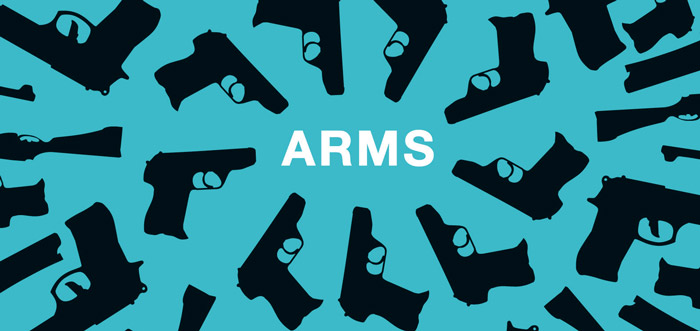A.J. Somerset blends a barrell full of personal anecdotes with historical analysis in Arms: The Culture and Credo of the Gun to explore the rise of gun culture in North America.
Somerset, a former Canadian soldier and avid sport shooter, offers a unique perspective into how and why guns have morphed from a tool of war, hunting, and protection to a polarizing symbol. Deeply critical of the political ideologies connected to gun usage, Somerset looks to differentiate himself from other self-identified gun enthusiasts.
“Although I like guns,” he writes in his introduction, “I do not like gun nuts.”
The rest of Arms follows this general theme, criticizing right-wing extremism and dogmatic positions on gun control. By tracing the lineage of gun lobbying, Somerset explains in detail how the National Rifle Association (NRA) and Canadian lobbying groups like the National Firearms Association (NFA) were able to exercise control over legislation and court decisions. Their advocacy is increasingly divorced from mainstream thought, but their supporters still represent a powerful constituency.
Somerset does not limit this book just to issues of public policy. The notion of a national ‘gun culture’ expands beyond how the term is usually used in public discourse. He provides the context for how the United States developed “a culture that declares the gun to be as American as mom and apple pie, and as sacred as Jesus himself.”
Somerset’s exploration of the psychology behind gun ownership is where Arms truly shines. The later chapters examine the way media, politics, and historical perceptions have carved out the social space for this culture to thrive. Highlights include the chapter “Kingdom of Fear,” an analysis on self-defense preparation and mass paranoia, as well as a section titled “A Woman’s Right,” a more methodical examination of how gun advocates appropriated feminist messaging. The chapter in which Somerset argues “gun control in the United States was about race from the start” is also particularly thought-provoking due to the current political and social climates.
Throughout the book, Arms includes anecdotes and metaphors to enhance his arguments. Sometimes these personal stories are refreshing and insightful because they sharply deviate from traditional non-fiction prose on this topic; however, other times they muddy up his reasoning and make Arms difficult to follow.
Furthermore, although Arms attempts to holistically explain gun culture in the United States and Canada, Somerset focuses almost entirely on radicalized elements within the subculture. The less fanatical—but still influential—voices are ignored, and the book does not discuss how more commonplace gun usage affects culture. The end result is an enforcement of a rigid dichotomy between what is presented as well-reasoned liberal beliefs and crazy far-right extremism. Society’s issues surrounding gun control are more nuanced.
Regardless of readers’ personal positions on firearms issues, nobody can deny the relevance of Arms today. Horrific mass shootings have characterized the American socio-political landscape. Guns have been presented as both the cause of and solution to these tragedies. Additionally, Somerset reminds Canadians that they are not exempt from these problems.
“These ideas have come across the border and taken hold in Canada, even as the mass of the Canadian public congratulates itself on living where there is no gun culture,” he writes. Arms offers a well-researched perspective on political and cultural issues that are constantly developing, and provides entertaining insights into gun culture that can appeal to gun rights novices and those who are already well-versed in this debate.









